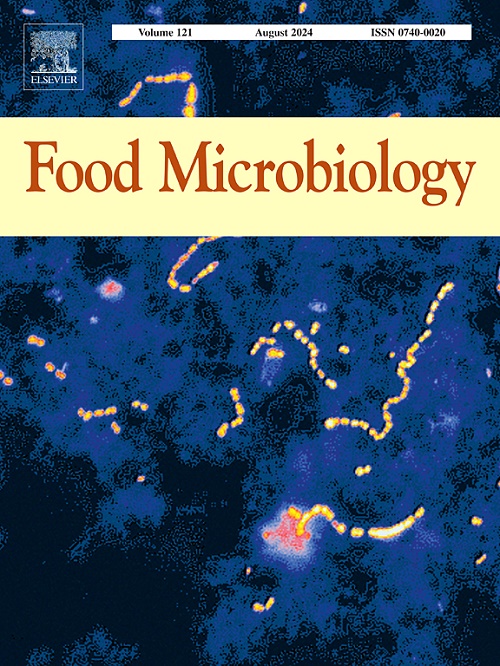用于检测屠宰场猪肠系膜淋巴结沙门氏菌的 ELIME-IMS 混合分析法
IF 4.5
1区 农林科学
Q1 BIOTECHNOLOGY & APPLIED MICROBIOLOGY
引用次数: 0
摘要
猪屠宰场的沙门氏菌污染与猪场的感染率有关。重型猪的准确诊断有赖于从肠壁或淋巴结中分离病原体。一项关键技术是使用磁珠进行免疫捕获(IMS),从沙门氏菌富集肉汤中纯化目标细菌。然后再使用酶联免疫磁性电化学(ELIME)检测法进行快速检测。在我们的研究中,我们开发了一种 ELIME-IMS 混合检测法,用于检测猪肠系膜淋巴结(MNL)中的沙门氏菌,包括用 N-乙酰半胱氨酸净化和离心。估计伤寒沙门氏菌和德比沙门氏菌的检测限分别为 2.80 和 3.52 Log CFU/ml。我们分析了来自意大利北部屠宰场的 103 份 MNL 样品。此外,我们还检测了 15 份胴体拭子。ELIME 检测法和基于 IMS 的培养法与 ISO 6579-1:2017 方法的一致性很高,尤其是在富集 20 小时后(一致性为 89.47%)。净化步骤对结果有很大影响,因为未经过净化步骤处理的样品显示出更高的变异性。逻辑回归模型表明,使用 ELIME 值对阴性样品进行分类的准确率很高。ELIME-IMS 检测法有助于快速筛查和分离猪肠系膜淋巴结中的沙门氏菌。本文章由计算机程序翻译,如有差异,请以英文原文为准。
ELIME-IMS hybrid assay for Salmonella detection in swine mesenteric lymph nodes at slaughterhouse
Salmonella contamination in pig slaughterhouses is linked to infection rate on farms. Accurate diagnosis in heavy pigs relies on isolating pathogens from the gut wall or lymph nodes. A key technique is Immunocapture using Magnetic Beads (IMS), which purifies target bacteria from Salmonella enrichment broths. This is followed by an Enzyme-Linked Immunomagnetic Electrochemical (ELIME) assay for rapid detection. In our study, we developed an ELIME-IMS hybrid assay to detect Salmonella in swine mesenteric lymph nodes (MNL), involving a clean-up with N-acetylcysteine and centrifugation. Detection limits for S. Typhimurium and S. Derby were estimated at 2.80 and 3.52 Log CFU/ml, respectively. We analysed 103 MNL samples from a northern Italy slaughterhouse. Additionally, we examined 15 carcass swabs. Both the ELIME assay and the IMS-based culture method showed strong agreement with the ISO 6579–1:2017 method, especially after 20 h of enrichment (89.47% concordance). The clean-up step significantly influenced the results, as samples processed without it showed higher variability. A logistic regression model indicated high classification accuracy for negative samples using ELIME values. The ELIME-IMS assay facilitates rapid Salmonella screening and isolation in swine mesenteric lymph nodes.
求助全文
通过发布文献求助,成功后即可免费获取论文全文。
去求助
来源期刊

Food microbiology
工程技术-生物工程与应用微生物
CiteScore
11.30
自引率
3.80%
发文量
179
审稿时长
44 days
期刊介绍:
Food Microbiology publishes original research articles, short communications, review papers, letters, news items and book reviews dealing with all aspects of the microbiology of foods. The editors aim to publish manuscripts of the highest quality which are both relevant and applicable to the broad field covered by the journal. Studies must be novel, have a clear connection to food microbiology, and be of general interest to the international community of food microbiologists. The editors make every effort to ensure rapid and fair reviews, resulting in timely publication of accepted manuscripts.
 求助内容:
求助内容: 应助结果提醒方式:
应助结果提醒方式:


